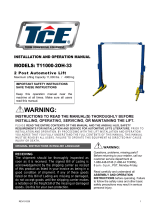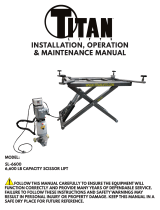
5
INSTALLER / OPERATOR
PLEASE READ AND FULLY
UNDERSTAND.
BY PROCEEDING YOU AGREE TO
THE FOLLOWING.
t I have visually inspected the site where the lift is
to be installed and veried the concrete to be in good
condition and free of cracks or other defects. I understand
that installing a lift on cracked or defective concrete could
cause lift failure resulting in personal injury or death.
t I understand that a level oor is required for proper
installation and level lifting.
t I understand that I am responsible if my oor is of
questionable slope and that I will be responsible for all
charges related to pouring a new level concrete slab if
required and any charges.
t I understand that Bendpak lifts are supplied with
concrete fasteners meeting the criteria of the American
National Standard “Automotive Lifts - Safety Requirements
for Construction, Testing, and Validation” ANSI/ALI
ALCTV-2006, and that I will be responsible for all charges
related to any special regional structural and/or seismic
anchoring requirements specied by any other agencies
and/or codes such as the Uniform Building Code (UBC)
and/or International Building Code (IBC).
t I will assume full responsibility for the concrete oor
and condition thereof, now or later, where the above
equipment model(s) are to be installed. Failure to follow
danger, warning, and caution instructions may lead to
serious personal injury or death to operator or bystander
or damage to property.
t I understand that BendPak lifts are designed to
be installed in indoor locations only. Failure to follow
installation instructions may lead to serious personal injury
or death to operator or bystander or damage to property
or lift.
Failure to follow danger, warning, and caution
instructions may lead to serious personal injury or death
to operator or bystander or damage to property.
Please read entire manual prior to installation. Do not
operate this machine until you read and understand
all the dangers, warnings and cautions in this manual.
For additional copies or further information, contact:
BendPak Inc. / Ranger Products
1645 Lemonwood Dr.
Santa Paula, CA. 93060
1-805-933-9970
www.bendpak.com
INSTALLER / OPERATOR
PROTECTIVE EQUIPMENT
Remember, personal protective equipment helps makes
installation and operation safer, however, it does not
take the place of safe operating practices. Always wear
durable work clothing during any installation and/
or service activity. Shop aprons or shop coats may
also be worn, however loose tting clothing should be
avoided. Tight tting leather gloves are recommended
to protect technician hands when handling parts. Sturdy
leather work shoes with steel toes and oil resistant soles
should be used by all service personnel to help prevent
injury during typical installation and operation activities.
Eye protection is essential during
installation and operation activities. Safety
glasses with side shields, goggles, or face
shields are acceptable. Everyday
eyeglasses only have impact resistant
lenses, they are not safety glasses. Back belts provide
support during lifting activities and are also helpful in
providing worker protection. Consideration should also be
given to the use of hearing protection if service activity is
performed in an enclosed area, or if noise levels are high.
THIS SYMBOL POINTS OUT IMPORTANT SAFETY INSTRUCTIONS WHICH IF NOT FOLLOWED
COULD ENDANGER THE PERSONAL SAFETY AND/OR PROPERTY OR YOURSELF AND OTHERS
AND CAN CAUSE PERSONAL INJURY OR DEATH. READ AND FOLLOW ALL INSTRUCTIONS IN
THIS MANUAL BEFORE ATTEMPTING TO OPERATE THIS MACHINE.





















